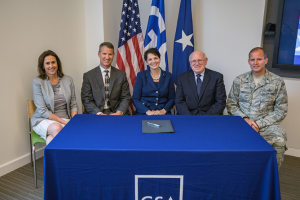In an earlier blog post, Transforming Government IT Procurement: Better Contracting Initiative Priority 2, I introduced the Better Contracting Initiative (BCI) as a driving force behind our ongoing efforts to modernize government IT procurement.
I described the Governmentwide Acquisition Strategy initiative led by the IT Vendor Management Office (ITVMO) to centralize engagement with critical Original Equipment Manufacturers (OEMs) and negotiate universal contract and process improvements to ensure that all agencies benefit from best-in-class terms and pricing as “One Customer.”
Today, I’ll provide details on the ITVMO’s Governmentwide Microsoft Acquisition Strategy (GMAS), an unprecedented initiative to forge a strategic partnership between the government and Microsoft, and provide immense value to the government and one of its critical IT suppliers.
The GMAS origin
In 2023, the ITVMO launched the GMAS initiative to help standardize government contract terms and pricing for Microsoft products and services, offered by many resellers, regardless of where or how agencies acquire them. The goal was to consolidate best-in-class terms into a universal term sheet that agencies could apply to any government buying vehicle. With best-in-class terms and enhanced cybersecurity standards, all government agencies, large and small, would benefit from the U. S. government’s size and weight, and avoid the inefficiencies of negotiating certain contract terms at each procurement. The process was designed to be collaborative, both across the government and with Microsoft, to generate efficiencies for all parties.
Comprehensive due diligence and preparation
After reviewing Microsoft contracts from each of the 24 Chief Financial Officers (CFO) Act agencies, the ITVMO compiled a list of 150+ contract terms and conditions worthy of standardization due to their varying language and benefits. ITVMO also performed an extensive price analysis that revealed substantial variance in pricing from resellers due to factors not always driven by “size of the prize.”
These contractual and price variances revealed an opportunity to capitalize on identified flexibilities, establishing best-in-class contract elements to apply to all government contracts.
With every CFO Act agency participating, the ITVMO hosted a Civilian Services Acquisition Workshop (C-SAW). Over two days, the group collaboratively concentrated the original list of terms and price reduction concepts down to 24. These 24 items comprised the foundation of the GMAS initiative.
Partnership with Microsoft
Over the course of several months, the ITVMO, Office of Management and Budget, and Microsoft’s Federal Division discussed the government’s requests and proposed additional ways to establish a strategic partnership.
The teams walked through each item to understand the specific requests and the underlying challenges. Stakeholders from Cybersecurity and Infrastructure Security Agency (CISA) engaged with Microsoft’s cybersecurity teams to discuss the critical security elements and standards that GMAS aimed to achieve.
Recently, the government provided a detailed compendium of solutions for Microsoft to formally consider at the corporate level, as many of the items require updates to long-standing corporate policies. Considerations and discussions on the original 24 challenges are ongoing as of October 2024.
Looking ahead
Microsoft has committed to working with the ITVMO to advance the initiative’s progress. We will continue to work with Microsoft to finalize a path forward. Throughout the project, Microsoft has acknowledged how implementing consistency across contracts between agencies and resellers would improve its performance as a product and service provider.
Having spent the last six months working with Microsoft, the government is pleased with the emerging alliance. Clearly, both sides value the other as a critical partner, as demonstrated by the willing collaboration of the GMAS effort. The government is confident that this project will yield unprecedented success and pave the way for more strategic endeavors with other critical IT industry partners.
The GMAS initiative is truly a first-of-its-kind effort to solidify the government as “one customer” in the eyes of a critical industry partner. Building on the anticipated success of GMAS, the ITVMO intends to launch similar efforts with other IT OEMs in FY25.
Stay tuned for more updates on GMAS and upcoming ITVMO initiatives to improve IT buying conditions for the federal government.
Visit our website to learn more about how GSA’s Office of Information Technology Category addresses the BCI through the ITVMO.
Please follow us on LinkedIn to join our ongoing conversations about government IT.
To get updates for this blog, please sign up on the right-hand side of the page where it says Sign up for Blog Updates.
